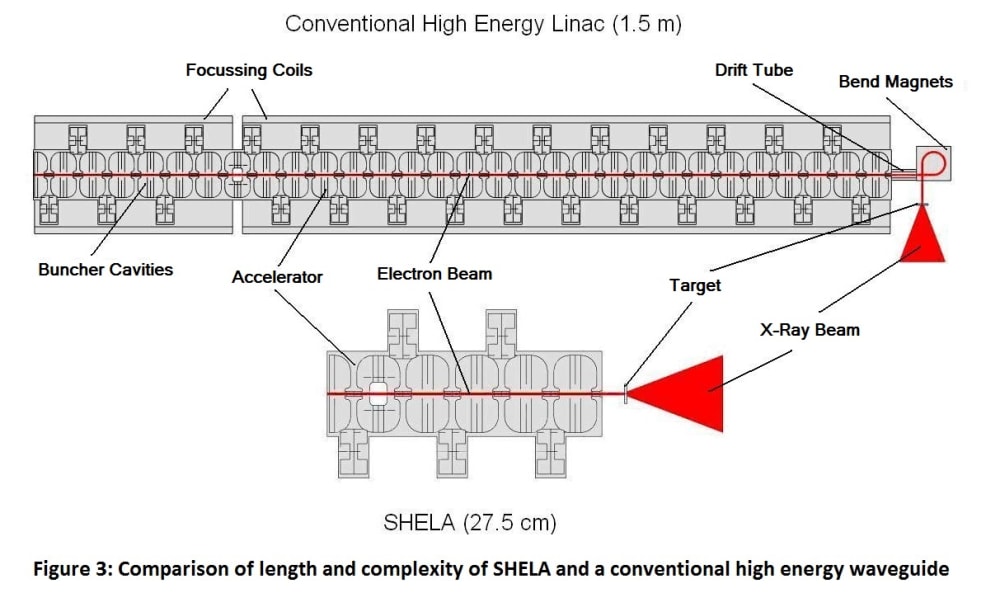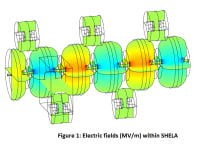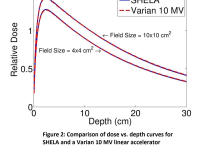
Linac-MR systems are poised to revolutionize radiation cancer therapy in the very near future. These systems will allow real-time 3D tracking during radiation therapy in order to optimize the radiation delivery to the cancer tumor, while the patient moves and breathes (something not possible with current technologies). The first linac-MR systems are currently being developed, and use a 6 MV linear accelerator (linac) to generate the x-rays needed to kill cancer in radiotherapy. In order to take full advantage of this new technology, however, higher x-ray energies are also needed for the optimal treatment of all cancers; more than half of all cancer patients are currently treated with higher energies using conventional technologies. Current high-energy linacs are large, complicated, and expensive devices which can’t easily be used in linac-MR systems. No simple, inexpensive, and compact high-energy clinical linac currently exists on the market.
Motivated by the need for higher energies in linac-MR systems, we designed a Short, High-Energy Linear Accelerator (SHELA). SHELA was designed in full 3D using COMSOL such that arcing will not occur, which is the major concern when trying to achieve higher energies from a shorter linac. By carefully designing the cavity structure, we keep the electric fields inside (figure 1) low enough that arcing cannot occur. The linac was then optimized until the depth dose curves (figure 2) generated using Monte-Carlo particle-transport software matched those generated from existing high energy linacs. All of this was accomplished while keeping the same length as the 6MV waveguide currently used and therefore avoiding the need for the bend magnets, focusing coils and bunching cavities required for current high-energy linacs (figure 3). SHELA does not require many of the components found in current high-energy linacs, and as an S-band (3 GHz) linac is a very inexpensive alternative for compact high-energy x-ray generation.
Because of its simple and compact design, SHELA is ideal for use with Linac-MR systems. It is the same length (27.5cm) as the 6MV linac used in the linac-MR system being developed at our center (Cross Cancer Institute, Edmonton, Alberta) and was designed to be a drop-in replacement. No modification to current linac-MR designs are needed: the 6MV accelerator can be directly replaced with SHELA to enable energies up to 10MV. This will allow linac-MR systems to optimally treat the >50% of patients that are currently treated with high-energy x-rays, including patients with deep seated tumors and breast tumors in large breasted patients. As SHELA is the only high-energy linac designed for compatibility with linac-MR systems, it will have applications everywhere linac-MR systems are being developed or used.
In addition to linac-MR applications, SHELA can see widespread use in conventional radiotherapy. In many regions of the world, high-energy (>6MV) radiotherapy is cost prohibitive, with many countries using out-dated cobalt-60 units for radiotherapy. As more than half of all new cancer cases worldwide are in the developing world, SHELA has the potential to bring high-energy radiotherapy to many patients who would not otherwise have access.
-
Awards
-
 2014 Top 100 Entries
2014 Top 100 Entries
Like this entry?
-
About the Entrant
- Name:Devin Baillie
- Type of entry:individual
- Software used for this entry:COMSOL, Parmela, Opera3D, EGSnrc
- Patent status:none








